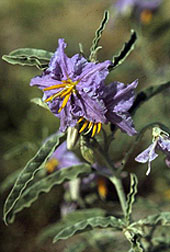This page has been archived and is being provided for reference purposes only. The page is no longer being updated, and therefore, links on the page may be invalid.
| Read the magazine story to find out more. |
|
|
|
|
Overseas Lab Seeks U.S. Weed Control "Recruits"
By Jan SuszkiwNovember 24, 2010
The search is on for insects, mites, microbes or nematodes that could be used in a biologically based approach to controlling silverleaf nightshade, an invasive weed from the Americas that has spread to southern Europe, Africa, India, Australia and elsewhere.
According to U.S. Department of Agriculture (USDA) entomologist Walker Jones, the perennial weed, Solanum elaeagnifolium, is being targeted for its ability to outcompete native plants, reduce crop yields and diminish pasture productivity. Its orange, toxin-producing berries can also poison livestock.
Severe infestations of silverleaf nightshade can render chemical or mechanical controls, like mowing, too costly, impractical or environmentally harmful to use, added Jones. He initiated the search for the weed's natural enemies as director of the European Biological Control Laboratory (EBCL), operated in Montpellier, France, by the Agricultural Research Service (ARS). ARS is USDA's principal intramural scientific research agency, and this research supports the USDA priority of promoting international food security.
Before returning to the United States this past April to lead the ARS Biological Control of Pests Research Unit in Stoneville, Miss., Jones, together with ARS National Program Leader Daniel Strickman, established a cooperative project with the Benaki Phytopathological Institute in Athens, Greece, to explore starting continental Europe's first-ever classical weed-biocontrol program. Candidate biocontrol agents are typically insects that severely damage or kill targeted weeds, sparing useful plants and striking a balance between the weed and its environment, explained Jones.
Normally, the EBCL serves as a "way station" where promising biocontrol agents collected from Europe, Asia or Africa are screened for potential release into the United States to manage invasive species there. But in this instance, the lab will serve as a receiving point for candidate organisms from North America that could open the door to biologically controlling infestations of the weed in Greece.
The project's early stages include genetically analyzing silverleaf nightshade populations collected from around the world and physically mapping Greece's infestations of the weed and densities using satellite photographs.
Read more about the research in the November-December 2010 issue of Agricultural Research magazine.

